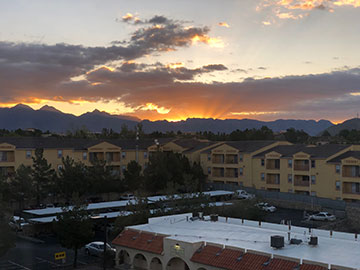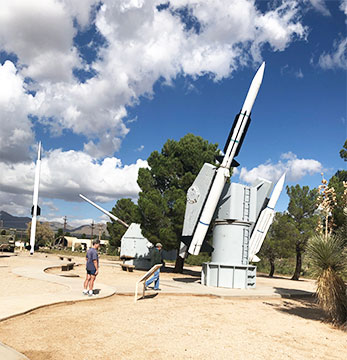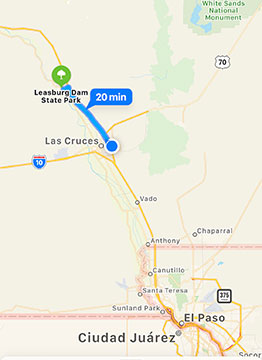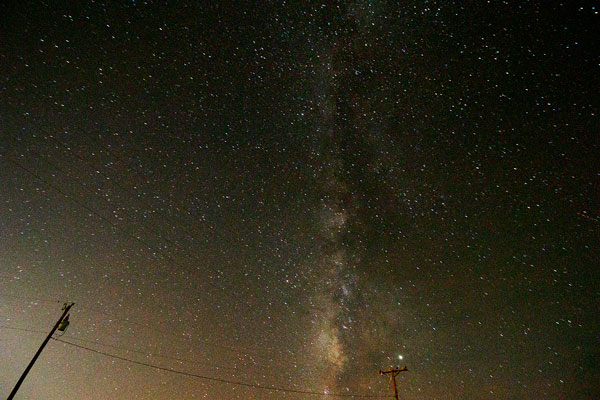Well this blog post is from offsite in Las Cruces, New Mexico for 108th AAVSO meeting. But on this free day before the meeting begins we had a chance to Clyde Tombaugh's Stain Glass Window, tour White Sands Missile Museum and see some great views of the Milky Way.
So, Las Cruces is just a short couple of flights from OC. It is easily reached with a one hour flight to Phoenix and then another one hour flight to El Paso, Texas, after which you have about a 50 minute drive to Las Cruces. The AAVSO meeting is in the Hotel Encanto, which is a convenient place to stay too. After checking in and having dinner and a couple of delicious their seasonal cocktails, called the Arbusto Tamarindo, it was time to call it a night. After waking up in Las Cruces I could spy this sunrise outside from the hotel room window. Pretty neat!
 |
| Sunrise in Las Cruces, NM (Source: Palmia Observatory) |
The local Astronomical Society of Las Cruces (ASLC) had some great suggestions for visitors. They recommended seeing the stained glass window in the Unitarian Church. Clyde Tombaugh was an early member and founder in 1955 and after he died in 1997, the congregation commissioned the stained glass window there. The five panels depicts scenes from Clyde's childhood, with images of the solar system and rockets and telescopes.The church is only a couple of miles from the hotel, so I drove down there to take a look.
 |
| Clyde Tombaugh's Stain Glass Window in the Las Cruces Unitarian Church (Source: Palmia Observatory) |
Now one of my primary goals on this free day was to tour the nearby White Sands Missile Museum. In a previous life, I had done a lot of engineering work on autopilots for Naval missiles, several of which were tested at White Sands Missile Range (WSMR). So, I wanted to go to the museum and find some of history of testing the missiles that I helped design. The WSMR is just 1/2 hour away from Las Cruces.
 |
| White Sands Missile Range is 1/2 hour from Las Cruces (Source: iPhone Maps) |
WSMR is an active military installation and you have to go through security to get inside. The museum is just inside the main gate entrance, but once you get your visitor pass you still have to drive through the main gate and the armed guards will ask to search your vehicle. Now this brought back some anxious memories from the past when I was working and had to do the same thing. I remember it was not easy to remember how to open everything up on the rental car and when the guard is standing over you with a machine gun and looking annoyed that you are taking way too long. Well this time the same thing happened because even though I knew how to open the trunk, I had to get out and search for the hood release. Hmm, again here is the annoyed looking armed guard wanting me to get things together. Ok, it finally worked out ok and into the museum I drove!
The entrance rules were also very clear about what not to take photos of and not so surprisingly, the direction I wanted to look I was not allowed. When I was working, I had never had a chance to be at WSMR when about a couple of dozen SM2 flight test rounds, that I helped build, were launched and fired. My boss got to go, but I was left at work wondering what it looked like.
Anyway, here is the WSMR museum, in the direction you can look, and the mountains in the background. On a separate issue, I was a bit worried about the heavy clouds moving in.
 |
| White Sands Missile Museum with background mountains (Source: Palmia Observatory) |
The museum has a missile park with many prototypes of the many dozens of different missiles that were tested here. WSMR got its start in 1945 when they first started testing captured V-2 rockets. There is still a V-2 rocket on display, but what I wanted to see was the SM-2 missile. Shown below is a SM-2 and another extended range version with a booster on the launcher. It was neat and fun walking trough the missile park and remembering all of the missiles from the past.
 |
| SM2 on launcher at White Sands Missile Museum (Source: Palmia Observatory) |
The ASLC website also identified several dark sky sites near Las Cruces. Now Las Cruces has about 100,000 inhabitants and the viewing near the hotel was pretty light polluted, but one of the nearby recommendations was the Leasburg State Park, which was about 20 minutes drive from the hotel. Driving away from Las Cruces, I could see the sky just keep getting darker and darker, but when I got to the exit to the Park, that is also where the little community of Radium Springs was located. Hmm, well, no matter, the skies were still very dark.
 |
| Dark sky site at Leasburg State Park (Source: iPhone Maps) |
My main astrophotography goal was to view and photograph the Milky Way. You Orange County guys know the Milky Way is even when you don't get a chance to see in on our home turf. The Safari Pro app showed the Milky Way right between Saturn and Jupiter. I could see those two planets from the hotel parking lot, but no Milky Way was visible from that location.
 |
| Sky Safari Pro screenshot with Milky Way (Source: Palmia Observatory) |
But, wow, when I stepped out of the car at the entrance gate to the now closed Leasburg State Park, the Milky Way was instantly visible. No need to let your eyes accommodate to the dark here. I had just packed my lightweight flimsy camera tripod and I sure hoped the wind was not blowing when I got to the park. Luckily the wind was down to zero and I was able to get a couple of long exposures. I used the widest 10mm focal length with ISO set to about 800 and took several shots, first at 30 seconds exposure and then at 60 second exposure. Hooray, yep, that is the Milky Way!
 |
| Milky Way from Leasburg State Park, DSLR, 12mm, 30 seconds (Source: Palmia Observatory) |
 |
| Milky Way from Leasburg State Park, DSLR, 12mm, 60 seconds (Source: Palmia Observatory) |
Ok, the fun is over now and it is time to get back to the hotel and get ready for two full days of AAVSO meetings and then after that get on the bus for the tour of the Apache Point Observatory.
Until next time,
Resident Astronomer George
Be sure to check out over 300 other blog posts on similar topics
If you are interested in things astronomical or in astrophysics and cosmology
Check out this blog at www.palmiaobservatory.com

No comments:
Post a Comment